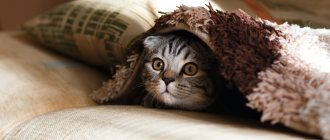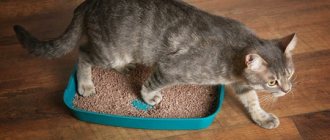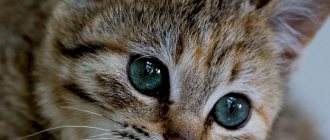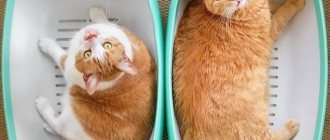Teaching your pet to use a litter box is not at all difficult - cats, like people, find the most convenient place as a toilet. They quickly understand what the purpose of this container is. If problems do arise with this, they can be difficult to solve, but do not despair.
Cats pee for two reasons: to defecate and to mark territory. Today we will deal only with the first aspect. If your cat marks walls and furniture, this article will not help you.
Training an animal to use a tray is a task associated mainly with psychology. If the owners are able to see what is happening through the eyes of a cat and create comfortable conditions for the pet, they just need to show enthusiasm, and everything will work out.
Choosing a place for the toilet
Cats are delicate creatures. They choose secluded corners, hidden from prying eyes, as a latrine. Therefore, you also need to choose such a place for the tray in the house. The most suitable place to place a cat litter box in an apartment would be a bathroom or toilet, as well as a balcony (loggia), if it is insulated. In addition, do not forget that the animal must be able to freely approach its toilet at any time. This will allow you to quickly and easily accustom your cat to the new toilet.
The kitchen and hallway are absolutely not suitable for cat litter. Firstly, this is unacceptable from the point of view of apartment hygiene. Agree that a toilet (even a cat’s) has no place in the kitchen, where food is prepared, or in the hallway, where people dress and put on their shoes. A generally suitable place can be considered a pantry if it is convenient for you and your cat. Secondly, a cat may refuse to use the toilet where people are often: she, as already mentioned, is a delicate creature.
Shape and material
Today, high-sided cat litter boxes come in many different shapes (for example, streamlined and angular, rectangular and oval). In this case, the tray can be not only symmetrically rectangular. Manufacturers' lines include straight and angular models, as well as options with different side heights. For example, they can increase in height in waves.
In corner-type models, the height of the front sides is lower than that of the sides that are placed against the wall. Other varieties even have the semblance of a panel that protects the wall from contamination (for example, accidental ingress of wet granules, excrement or cat urine). As for the manufacturing material, plastic is used in the production of cat litter boxes.
The material itself may differ in density, which the buyer should pay attention to when choosing a particular model
Selecting a tray
If an adult cat didn’t know what a litter box was before she moved into your house, then she should like it: it should be spacious and comfortable enough for her to recognize it as a toilet. What does a convenient tray mean? First of all, it is deep: after all, it is intended for an adult animal. The depth of the tray should not be less than ten centimeters. This will allow the cat to dig around in it to prepare a place for the intimate process, and then hide its results. In addition, the high sides of the tray will prevent the filler from spilling onto the floor. And the width and length of the tray should be sufficient for the animal to fit completely in it.
An alternative to a cuvette tray will be a special toilet house, which will be convenient for the cat and will make it easier for you to care for the cat litter box. The fact is that such special houses are equipped with filters that clean the air from the natural smell of what remains in it after a cat’s visit there. And if you do not have time to remove the tray in time, the filters will neutralize the odor. Cats also begin to relieve themselves with great pleasure, using the houses, since such toilets are equipped with a roof and walls and completely hide the cat from prying eyes. Yes, and you can place such a closed toilet not only in the bathroom, but even in the hallway - this will not bother a cat.
Quality standard options
Homecat De Luxe 53x39x23 cm
A good model with an attractive design that every cat will like. The tray has optimal dimensions, so the animal will not experience discomfort. The appearance fits easily into the interior. Made from premium plastic, which is scratch-resistant and easy to clean from various contaminants. Sold in 4 different colors. High sides will prevent contamination of the floor covering.
The average cost is 785 rubles.
Homecat De Luxe 53x39x23 cm
Advantages:
- Optimal sizes;
- No plastic smell;
- Easy to clean with water and soap;
- The design is easy to disassemble;
- High sides.
Flaws:
Dogman Triplex small 41x31x13 cm
A small option that is suitable for small cats and kittens. The product is equipped with a special grille, which is a positive solution. There are small sides, which has a positive effect on convenience. The design can be easily disassembled and washed from various contaminants. The grilles are made of durable materials and do not deteriorate from frequent exposure to claws.
Dogman Triplex small 41x31x13 cm
Advantages:
- High quality manufacturing;
- Attractive design;
- Removable grille;
- Easy to disassemble;
- Can be washed with simple means.
Flaws:
Siberian cat Euro deep with mesh and side 44x32x16 cm
A high-quality option that can be used with various fillers. For convenience, there is a mesh that retains feces. Therefore, you don’t have to clean the tray every day. The configuration of the side is designed taking into account the needs of the animals. Non-toxic plastic was used in production, which increases the safety of the pet.
The average cost is 390 rubles.
Siberian cat Euro deep with mesh and side 44x32x16 cm
Advantages:
- Value for money;
- Long service life;
- Convenient use;
- High quality manufacturing;
- Attractive appearance.
Flaws:
We train a cat to use the toilet
Very often, animals intuitively understand what the tray prepared for them is intended for. Still, you will have to make some efforts to accustom an adult cat to a new toilet. By the way, the popular belief that it is easier to train a cat to a litter box than a cat is incorrect. Yes, of course, the cat is driven by the instincts of the male, according to which he must mark the territory in a known way. Therefore, very often in a new environment the animal begins to leave marks. But the cat is more capricious. And if she doesn’t like the place, she will stubbornly refuse to go to the litter box and will choose the place for the toilet herself. But let's start in order.
First, you need to keep an eye on the animal. The cat will want to relieve itself soon after eating. Although, we note, they can endure for a long time. By the way, you can introduce your cat to the toilet immediately after it appears in the house. As we have already said, animals often intuitively understand the purpose of the tray. If this happened in your case, then the problem is solved: once you go to the litter box, the cat (or cat) will begin to use it constantly.
But if the animal does not immediately recognize its toilet in the tray, then wait until the need for it arises. Having wanted to go to the toilet, the cat will begin to look for a secluded place to relieve itself. Noticing this, take the animal, take it to the tray and put it in it. Stroke, calm and move away. Most likely, the cat will begin to dig into the litter, pave the way, and eventually do its job in the litter box. If she jumps out of the litter box and tries to escape, return her to the litter box again and again until she relieves herself there.
Another variant. Seeing that the cat has chosen a place and is already pooping to pee or poop, quickly place the tray in this place and put the animal in it. Being almost in the process, the animal will continue the task once it is in the tray. Do not change the litter: next time the cat will start looking for the toilet by smell. If she goes back to her original place, then take her to the tray. Having smelled a familiar smell, the cat will use the tray for its intended purpose.
If the animal still returns to its original place, temporarily place the tray there and begin gradually moving it to where you originally intended to place the tray. This will take time, but for the animal such a process of movement will be invisible. And one more piece of advice.
If you adopted a cat from the street, then for the first time pour not litter into the tray, but ordinary soil or sand: the usual consistency and smell of what is in the tray will help the cat understand what the cuvette is intended for. If an animal poops in a secluded corner in your absence, blot the puddle with a napkin and place the napkin in the tray. If, in addition to the puddle, the animal left behind more visible traces, then transfer these “traces” to the tray as well. And generously treat the place chosen by the cat for the toilet with ammonia or vinegar essence: a strong and pungent smell will make the animal ignore this place.
Possible problems
It happens that you have to force an adult cat to go into the litter box, which until a certain point had willingly used it. Before scolding your animal, contact your veterinarian: such behavior may be a warning sign and indicate problems with the animal’s health. Such behavior of an adult cat may also indicate an inconvenient tray for him or an inappropriate place for the toilet. Let the cat choose a place for the tray and arrange a toilet there. Cats can also disdain a dirty litter box. Some animals meow demandingly, drawing your attention to the problem, while others silently ignore the dirty litter box, simply finding a new place to go to the toilet.
Many cats do not want to share a litter box with another animal. And if more than one cat lives in your house, then purchase a separate tray for each animal. In general, it is impossible to say exactly how easily you will be able to train your cat to use the toilet. It all depends on the character, temperament and intelligence of the animal. But nothing is impossible. With enough patience on your part, the cat will sooner or later recognize the litter box as a place for the toilet and will begin to go into it. Be persistent and inventive, and you will definitely succeed!
A lot of patience
Cats are sensitive to human emotions. In case of failures with litter box training, you need to try to find and eliminate the cause before taking out your irritation on the animal. Cats mark corners not to spite the owner, but because something confuses them in the place designated for the toilet. Take a closer look at your pet; perhaps he is uncomfortable in the new tray, the filler is too large and scratches his paws, or has an unpleasant aroma for the pet.
By eliminating negative factors and arranging comfortable conditions for the pet, the owner will be able to ensure that the animal visits the litter box without mistakes and get an affectionate, contented and purring friend.











